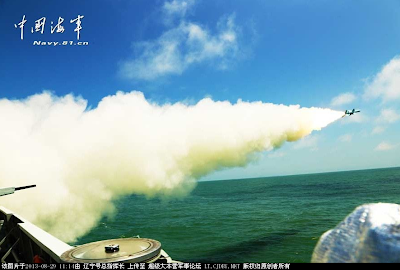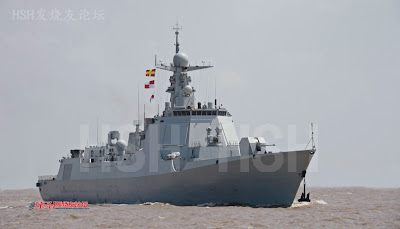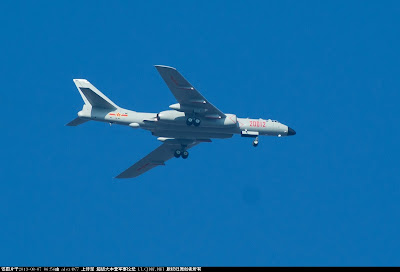Aug 30, 2013
Aug 26, 2013
China Z-10 Attack Helicopter Training With Air-To-Air Missiles
A Chinese-developed attack helicopter has successfully fired air-to-air missiles for the first time, state media said Monday, in another apparent advance for the domestic arms industry.
The firing took place last week during drills off the coast of the southern province of Guangdong that were the biggest test yet for the army's aviation wing, the Xinhua News Agency reported.
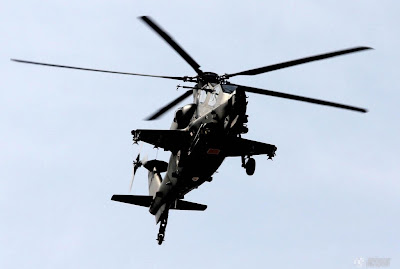 |
| Z-10 Attack Helicopter |
The aircraft were of the WZ-10 model developed by the domestic arms industry primarily for attacking tanks. Xinhua said its missiles successfully intercepted low-altitude targets during the drill, indicating an increased role for the helicopter in countering enemy aircraft.
China has shifted rapidly over the last decade from importing most of its military hardware from Russia to producing it at home, a result of the booming economy, increasing technical sophistication, and annual double-digit percentage increases in the defense budget.
Chinese Company Builds Massive Capacity 1,750 MW Nuclear Generator
Dongfang Electrical Machinery Co. Ltd (DFEM), a major Chinese power generating equipment manufacturer, has completed construction of a 1,750 MW nuclear generator and started transporting it to a nuclear power plant in south China on Saturday.
The 1,750 MW generator currently has the biggest per-unit installed capacity among the nuclear generators in the world, according to the DFEM,which is based in southwest China's Sichuan Province.
The generator is being sent to the Taishan nuclear power plant in south China's Guangdong Province from the company's production base in Deyang City, Sichuan Province.
DFEM will provide two such generators for the nuclear power plant.
DFEM has produced 14 nuclear generators so far with a total installed capacity of 15,790 MW.
The Taishan nuclear power plant is a joint venture of China Guangdong Nuclear Power Holding Co. Ltd (CGNPC) and Electricite de France.
According to CGNPC, the first-phase project of the nuclear power station got a total investment of 50.2 billion yuan (8.13 billion U.S. dollars), and would include the construction of two units using the Electron Paramagnetic Resonance (EPR) technology, with each unit capacity up to 1,750 MW.
The 1,750 MW generator currently has the biggest per-unit installed capacity among the nuclear generators in the world, according to the DFEM,which is based in southwest China's Sichuan Province.
The generator is being sent to the Taishan nuclear power plant in south China's Guangdong Province from the company's production base in Deyang City, Sichuan Province.
DFEM will provide two such generators for the nuclear power plant.
DFEM has produced 14 nuclear generators so far with a total installed capacity of 15,790 MW.
The Taishan nuclear power plant is a joint venture of China Guangdong Nuclear Power Holding Co. Ltd (CGNPC) and Electricite de France.
According to CGNPC, the first-phase project of the nuclear power station got a total investment of 50.2 billion yuan (8.13 billion U.S. dollars), and would include the construction of two units using the Electron Paramagnetic Resonance (EPR) technology, with each unit capacity up to 1,750 MW.
Aug 23, 2013
Aug 19, 2013
An Update On China's Domestic Military Aviation Projects
Over the past 5 years, we can see the dramatic improvement in the hardware of Chinese navy from all of the really nice new ships that have come out. As naval fleet has improved, it’s always been a wonder if the same advances can be found in aviation projects.
So far, we’ve seen both real success stories and areas where things are going slower than expected. In the civilian field, it seems like most of the projects are going rather badly. ARJ-21 is turning into a nightmare. At this point, it appears that AVIC-1 completely underestimated the work needed in integration that components, going through all of the needed test flights and most importantly actually certifying an aircraft. Even the certification process in China has dragged on way past the original delivery date. I think that C919 started off on a much better footing with greater involvement from foreign partners. However, we are now hearing news on those partners rethinking their commitment to the program and impending delay of maiden flight. These are not surprising since most major airliner projects experience delays these days. However, I think all that we have seen from ARJ-21 and C-919 projects would indicate that China has a lot to learn here. The learning curve in designing, certifying and building airliners is a very complicated process. There is a reason only Boeing and Airbus are capable of building the larger airliners. China needs to accept any help it can get from Western partners in an industry where few companies are willing to share their secrets. These are the reasons why China was so eager to partner up with Bombardier and also set up local production with Embraer and Airbus.
 |
| J-10 B |
China’s C4ISR Revolution is Coming
China’s military modernization has given rise to an enormous Western literature dissecting its scope and progress. Despite this boom, many analysts have paid relatively little attention to recent advances in the People’s Liberation Army’s (PLA) command, control, communication, computer, intelligence, surveillance, and reconnaissance (C4ISR) capabilities.
The PLA’s growing complement of manned and unmanned aircraft, reconnaissance satellites, and sophisticated ground-based infrastructure comprises the operational foundation of China’s emerging network-centric military. It is also the means by which better-known systems, such as the DF-21D “carrier-killer” anti-ship ballistic missile or the J-20 stealth fighter, could actually fulfill their intended roles during a major regional contingency.
rom recent developments in China’s C4ISR infrastructure, it is clear that PLA is well on its way to becoming a sophisticated global military possessing many of the same C4ISR capabilities enjoyed by U.S. forces although it remains to be seen whether organizational barriers will short-circuit this trend.
 |
| KJ-2000 |
Airborne C4ISR
Much if not most Chinese thinking on C4ISR and military modernization stems from analysis of the United States’ military performance in recent conflicts. For example, learning from the United States’ successful employment of specialized flying C4ISR systems, such as the E-3 Sentry, and the J-8 STARS, the PLA has identified Airborne Early Warning Command and Control (AEWC&C) aircraft as central to waging war against intervening naval and air forces. According to multiple Chinese analyses, a single airborne AEWC&C aircraft is the operational equivalent of roughly ten ground-based systems of comparable sophistication. In addition to facilitating real-time intelligence gathering, border surveillance, and command and control, these systems are expected to make PLAAF and PLAN fighter aircraft less susceptible to detection by affording them enhanced situational awareness without using their own radar systems. Historically, this capability has afforded the U.S. Air Force significant advantages in beyond visual range engagements that may now be lost.
Aug 15, 2013
Aug 11, 2013
Aug 10, 2013
China Caughting Up American and Israeli UAVs Design
Despite all the publicity that American UAVs receive, the major exporter of UAVs has been Israel. Between 2002 and 2012, Israel exported $4.7 billion worth of UAVs, approximately twice as much as the U.S. Part of this was due to the U.S. military demand for UAVs in Iraq and Afghanistan, which was largely met by American suppliers. But there were also U.S. government restrictions on American UAV exports. These restrictions still exist, for political reasons, such as prohibition of weapons sales to a long list of countries, and security fears.
These restrictions are becoming a major issue for U.S. UAV manufacturers because Israel already has a head start as an exporter, and China (using copies of many Israeli and U.S. UAVs) is catching up fast. The UAV market is expected to double to over $11 billion a year in the next decade and American firms have to export more in order to survive. The American military has cut purchases way back and will not be buying much for the next five years to come or more.
It’s understandable that the Israelis are leading exporters, as they developed most of the basic technology that made the best-selling American models like Predator and Raven possible. Israel kept developing UAV tech after successful American designs appeared. As a result of this trend, in the last decade nations have found that if they wanted American style UAVs very often they were unable to buy American for whatever reason but the Israelis probably had whatever they needed, with less restrictions and often at a better price.
These restrictions are becoming a major issue for U.S. UAV manufacturers because Israel already has a head start as an exporter, and China (using copies of many Israeli and U.S. UAVs) is catching up fast. The UAV market is expected to double to over $11 billion a year in the next decade and American firms have to export more in order to survive. The American military has cut purchases way back and will not be buying much for the next five years to come or more.
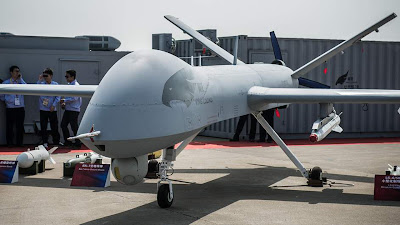 |
| CH-4 |
It’s understandable that the Israelis are leading exporters, as they developed most of the basic technology that made the best-selling American models like Predator and Raven possible. Israel kept developing UAV tech after successful American designs appeared. As a result of this trend, in the last decade nations have found that if they wanted American style UAVs very often they were unable to buy American for whatever reason but the Israelis probably had whatever they needed, with less restrictions and often at a better price.
US Hikes M-777 Artillery Price For India
The US Defense SecurityCooperation Agency (DSCA) issued a legally-required notification last week to the US Congress about the possible sale of 145 M-777 howitzers to India for USD 885 million.
But what many have failed to note is that the DSCA had first issued a notification about exactly such a sale on January 22, 2010 for the amount of USD 647 million.
 |
| M-777 |
In purely dollar terms, the new price represents a 37 percent hike in the cost of the offer to India. But the effective increase in price for India would be even higher, going by the fall in the value of the rupee against the dollar since 2010.
This second notification by the DSCA is actually less a communication to the US Congress of intent of possible sale and more an indication of the revised price of the offer to India. What is also interesting is that the second notification lays out offset requirements on the part of the manufacturers, which was not the case in the 2010 text.
Aug 8, 2013
Comac To Delay Maiden Flight of C919
Commercial Aircraft Corp. of China will delay the maiden test flight of the country’s first large passenger plane to 2015 from an earlier plan for next year, four company officials familiar with the plan said.
Comac, as the company is also known, delayed the flight of C919 because of certain procedures that aren’t linked to technical matters, the people said, declining to be identified as the information isn’t public. The Shanghai-based planemaker may notify suppliers about the decision as early as this month.
 |
| Comac C919 |
China is building the 168-seat plane as it tries to break Airbus SAS and Boeing Co. (BA)’s stranglehold in the global market for aircraft of this size. Last year, Comac asked its project designers to work 12-hour days, and also Saturdays, to meet the deadline for the maiden flight of the jet.
Japan Unveils Largest Warship Since World War II
Japan on Tuesday unveiled its biggest warship since World War II, a huge flat-top destroyer that has raised eyebrows in China and elsewhere because it bears a strong resemblance to a conventional aircraft carrier.
The ship, which has a flight deck that is nearly 250 meters (820 feet) long, is designed to carry up to 14 helicopters. Japanese officials say it will be used in national defense — particularly in anti-submarine warfare and border-area surveillance missions — and to bolster the nation's ability to transport personnel and supplies in response to large-scale natural disasters, like the devastating earthquake and tsunami in 2011.
Though the ship — dubbed "Izumo" — has been in the works since 2009, its unveiling comes as Japan and China are locked in a dispute over several small islands located between southern Japan and Taiwan. For months, ships from both countries have been conducting patrols around the isles, called the Senkaku in Japan and the Diaoyutai in China.
 |
| Japan Largest Warship |
The tensions over the islands, along with China's heavy spending on defense and military modernization, have heightened calls in Japan for beefed-up naval and air forces. China recently began operating an aircraft carrier that it refurbished after purchasing from Russia, and is reportedly moving forward with the construction of another that is domestically built.
Japan, China and Taiwan all claim the islands.
Though technically a destroyer, some experts believe the new Japanese ship could potentially be used in the future to launch fighter jets or other aircraft that have the ability to take off vertically. That would be a departure for Japan, which has one of the best equipped and best trained naval forces in the Pacific but which has not sought to build aircraft carriers of its own because of constitutional restrictions that limit its military forces to a defensive role.
JF-17 To Attain In-Flight Refueling Capability
The JF-17 Thunder fighter is all set to attain in-flight refueling capability, according to Chief of Air Staff Air Chief Marshal (ACM) Tahir Rafiq Butt.
“The ground tests have been very successful and I am satisfied. The air-to-air refueling test will be done successfully by end of this summer,” the air force chief said in an interview with Jane’s Defence Weekly.
The Pakistan Air Force acquired Ilyushin Il-78MP air refueling tankers from Ukraine back in 2010. According to ACM Butt, these are now being synchronised with the JF-17, giving it the capability to remain airborne for longer durations.
The PAF chief pointed out that th
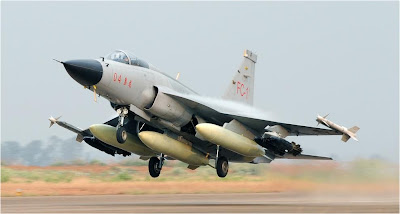 |
| JF-17 Thunder |
“The JF-17 programme has been an excellent project to pursue, owing to the hard work put in by our engineers, technicians and test pilots,” ACM Butt said, adding, “All this would also not have been possible without the cooperation of China.”
Meanwhile, answering a question pertaining to the induction of Chinese-built ZDK-03 airborne early warning aircraft, ACM Butt said the platform has so far shown that its capabilities work well over sea, and both lowland and mountainous terrain.
Aug 3, 2013
India Plans To Deploy 100,000 More Troops On China Border
India has planned to recruit and deployed another 100,000 troops along the disputed borders with China and the Chinese southwestern Tibet. The troop increase will come over the next five years, as part of a $13 billion modernisation programme that will mark the largest expansion of the Indian army throughout the sub-continental country’s 60-year history, a Chinese scholar has reported in state media.
Earlier this month, New Delhi gave the green light for the Indian military to deploy Brahmos cruise missiles south of Tibet in India’s first tactical missile deployment targeting China, according to the Indian media.
“India needs pause when driving East,” an article by Li Hongmei said. India is now afoot to give a major impetus to its ‘Look East’ policy, when it kicked start a flurry of diplomatic activities with Southeast Asian countries in the last two months, and, of late, with Japan.
India and Vietnam agreed in September to jointly explore oil resources in the South China Sea. Early in October, India and Afghanistan declared the establishment of strategic and cooperative partnership between them. Recently, India signed defence pacts respectively with China’s neighbouring Vietnam and Myanmar.
Qaher 313 Home-Made Fighter Jet to Protect Iranian Airspace
 |
| Qaher 313 |
On February 2, Iran unveiled an advanced home-made aircraft, named Qaher 313, in a ceremony attended by President Mahmoud Ahmadinejad.
Addressing a group of Iranian soldiers on Tuesday, Deputy Defense Minister General Majid Bokayee pointed to the confused remarks made by the US military analysts about the features and specifications of the aircraft, and said that enemies claimed the aircraft is just a paper model but later they said that it is an aircraft designed by the Islamic Republic for anti-chopper missions.
"That was the Americans' analysis, but we bravely declare that Qaher, (designed and developed) at a cost of $2 to 3 million, is a Basiji (volunteer) aircraft to protect the Persian Gulf," Bokayee noted.
In February, the aircraft's project manager told FNA that Qaher 313 has a "unique" structure and will be armed with home-made weapons and equipments in the future, adding that it enjoys such capabilities which will stun the enemies in battlefield.
"The new aircraft has a unique face in terms of shape and structure and its design is unique in the world," Managing-Director of Iran's Aviation Industries Company Hassan Parvaneh said at the time.
He added that the aircraft's broken wing design has gifted it the ability to fly in different low, mid and high altitudes.
"Of course, the specific capability of Qaher is its capability of flying at low altitudes and that is a capability seen in no other similar aircraft."
China Developing Large Amphibious Assault Ship
China is developing a large amphibious assault ship which is similar to the Landing Helicopter Assault ship in United States Navy on CCTV-4 “Today’s Focus” Interview program. Yin’s voice is China’s first time publicly expression on amphibious assault ship development and attracts media attentions.
 |
| China's PLA Navy Amphibious Assault Ship |
In the CCTV program, when the host asking that PLA new WZ-10 helicopters would be deployed on the aircraft carrier, Rear Admiral Yin Zhuo replied: “WZ-10 and WZ-19 may deployed in China’s future amphibious assault ship. And China now is developing a new generation of amphibious ship, 40000 ton displacement, like U.S. Navy Landing Helicopter Assault LHD ship. The heavy transportation helicopters on this amphibious assault ship will be escorted by armed choppers like WZ-10 and WZ-19.”
There were indications that the Chinese Navy amphibious assault ship has displacement of 48,000 tons. When PLA Navy has these warships, China will be able to deploy armed forces in any country of the Western Pacific area. Analysts pointed out that, once the Sino-Japanese military conflict breaks, Chinese warships will use this type of amphibious assault ship on Okinawa and the Japan four largest islands landing operations.
Subscribe to:
Comments (Atom)
-
Pakistan has witnessed new defense acquisitions in this decade than any other, and in the center of it all is the new fighter which ...
-
China's Stealth Helicopter It's a stealth heavy attack helicopter. US aviation experts say that it is designed to cou...
-
The terrorist attack on Karachi's Mehran Naval Station on May 22 was conceived and launched by India with the primary objective o...
